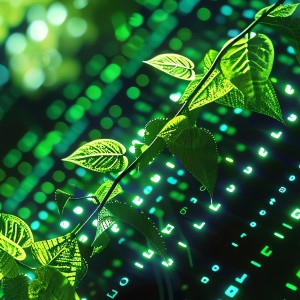
Climate change is a hot button issue in every industry these days, and software development is no exception. As the pressures we place on the environment continue to grow, organizations of all sizes are facing increasing pressure to limit their environmental impacts.
Thankfully, positive changes can be made. Green coding is emerging as a popular option for organizations looking to carry out ethical web development.
But what is green coding? How easily can it be implemented, and how can it benefit your organization? Read on to find out.
What is Green Coding?
Green coding refers to the practice of writing computer code with a focus on environmental sustainability and energy efficiency.
It’s part of the larger green IT movement and involves developing software in a way that minimizes energy consumption, reduces carbon emissions, and overall lessens the environmental impact of coding.
There are a variety of green coding strategies, including optimizing algorithms and data structures to reduce computational resources, writing code that runs more efficiently and requires fewer hardware resources, and utilizing energy-saving programming techniques.
Promoting green coding practices allows developers to take steps towards mitigating the environmental footprint of technology, advancing sustainability in the digital age.
The Sustainability Challenges of Computing
There are multiple sustainability challenges involved with computing that must be overcome to make green computing a reality.
E-Waste
Technical innovations are occurring at a rapid pace, which has led to shorter product life cycles and a significant amount of electronic waste (e-waste) as consumers replace their old gadgets with newer models. Improperly disposing of e-waste can harm the environment due to the toxic materials contained in many electronic devices.
Carbon Footprint
The carbon footprint of computing encompasses not only the energy consumption of devices and data centers, but also the manufacturing, transportation, and disposal processes associated with hardware and software components.
Water Consumption
Local water resources can often be impacted by technological demands, leading to environmental stress and water scarcity, particularly in regions with warm climates. For instance, data centers and data rooms can require large amounts of water for cooling purposes.
Energy Consumption
Computing consumes vast amounts of energy, which contributes to greenhouse gas emissions and environmental degradation. The increasing demand for computing power only exacerbates this issue.
To understand the positive impact that green coding can have on energy consumption, we can assess three key areas:
Infrastructure
The networks and physical hardware of an IT infrastructure all require energy to run. Many organizations will run overly complicated or overprovisioned computing infrastructures, which contributes to inefficiency.
Processing
Actually running software also consumes energy. More energy is consumed by complicated software that requires longer processing times.
DevOps
During the coding process, lines of code are written and then parsed and processed through a device, which requires energy. The more code that needs to be processed, the more energy the device consumes.
Green Coding Principles
The Green Software Foundation is a non-profit organization established in 2021. One of the key achievements of the Foundation has been the development of a series of standards and best practices for building green software.
There are eight fundamental principles designed to guide software engineers in their development. These eight principles of green coding are:
- Carbon: Applications should be built in a carbon-efficient manner.
- Electricity: Applications should be built in an energy-efficient manner.
- Carbon Intensity: Electricity should be consumed with the lowest carbon intensity possible.
- Embodied Carbon: Applications should be hardware-efficient.
- Energy Proportionality: The energy efficiency of hardware should be maximized.
- Networking: The amount of data, and distance it must travel across networks, should be minimized.
- Demand Shaping: Applications should be carbon-aware.
- Measurement & Optimization: Step-by-step optimizations that increase the overall carbon efficiency of applications should be introduced.
Additional Benefits of Green Coding
Green coding doesn’t only reduce the energy consumption of software development; there are additional benefits up for grabs, whether you’re a web design company in Dubai or a software developer in Toronto.
Given the long list of benefits, green coding should be as high on the agenda as rigorous testing or choosing the right domain extensions for software developers.
Meeting Sustainability Targets
Many organizations have put in place sustainability targets when it comes to energy efficiency and carbon footprints. Green coding can be a step towards reaching these targets, earning organizations goodwill from stakeholders and the general public.
Reduced Energy Costs
Green coding uses less energy, which in turn leads to lower overall energy bills. This is especially important today, as the price of energy remains volatile and can be a valuable lifeline for businesses looking to reduce their operational expenditure.
Improved Development Discipline
Instilling green coding principles among developers and programmers empowers them to apply these practices at every stage of development. For example, simplifying elaborate infrastructures reduces the amount of code programmers need to write, which ultimately reduces development time.
Implementing Green Coding
Implementing green coding within your organization often requires both structural and cultural changes; it’s not always as simple as coming up with ideas for a domain name. There are a variety of different approaches you can take when implementing green coding, some of the most effective of which we’ve outlined here.
Understanding Environmental Impacts
The first step when implementing green coding is to understand your existing environmental impact. This usually involves measuring several key factors:
- Energy consumption of development tools
- Energy consumption of end-user devices
- Energy consumption of network infrastructure
- Software life cycle analysis
- Code efficiency
There are a variety of tools that can assist with these calculations, such as carbon footprint calculation tools which take these factors, and more, into account.
Once you’ve got a clearer picture of how energy is consumed during development, you’ll have a better idea of where you can make changes to positively impact your energy usage.
Energy Efficiency
Optimizing resources and considering workloads to reduce energy consumption is the cornerstone of green computing. IT infrastructures can be optimized using modern tools such as virtual machines (VMs) and containers, reducing the number of physical servers needed for operations. This reduces energy consumption and carbon intensity.
Organizations have also managed to improve sustainability through the introduction of cloud computing, AI (Artificial Intelligence), and RPA (Robotic Process Automation).
Greater energy efficiency can be achieved by simplifying code logic and structure to make it easier to understand, maintain, and optimize. Complex code is more difficult to debug and optimize, meaning increased energy consumption is required during development and execution.
Writing efficient code is another key factor in green coding, as it minimizes the computational resources such as CPU cycles, memory usage, and disk I/O that are needed. Using algorithms and data structures that are optimized for performance will therefore reduce energy consumption during execution.
Microservices
Utilizing microservices is another increasingly popular approach to building applications. Simply put, it involves breaking down complicated software into smaller elements called services. Each smaller service is only called upon when it’s needed, as opposed to constantly running a large monolithic program. Applications built using microservices therefore run more efficiently.
Responsible Sourcing
Utilizing responsibly sourced hardware, software, and other materials will reduce the environmental impact of software development. Choosing development tools, frameworks, and libraries that are energy-efficient and have minimal impact on system resources is one example of this.
By opting for lightweight alternatives and avoiding bloated software packages, you can minimize energy consumption.
Empowering Employees & Encouraging Innovation
Introducing green thinking into your organization promotes mindfulness about sustainability, and encourages employees to implement green thinking and practices across all aspects of their delivery.
You should encourage the adoption of green thinking and practices through consistent messaging to the entire DevOps team. This helps to support the sustainability agenda at every level and makes people feel like they are an active part of the solution.
The shift towards distributed teams and remote working is a great example of this. Rather than having stakeholders from different locations fly or drive in for meetings, they can now participate through international calling or video conferencing, reducing the carbon emissions associated with business travel.
Fostering a culture of innovation will help further. Encouraging teams to look for green solutions to coding problems, pioneering new ways to use data insights, and identifying other energy-saving opportunities will reinforce green computing throughout the organization.
Longevity
Unfortunately, the lifecycle of software seems to be getting shorter and shorter.
Developing software designed to last can help reduce a product’s environmental impacts throughout its lifecycle. This reduces waste and promotes sustainability by reducing the need for frequent updates and replacements.
Creating software architectures that are modular, flexible, and scalable allows for software to be easily adapted and extended over time. This reduces the need for frequent rewrites or replacements, thereby conserving resources and reducing waste.
Software should also be designed to be compatible with existing systems and standards. This promotes interoperability and reduces the need for proprietary or specialized solutions. Software can then be used across a range of platforms and environments, extending its lifespan and reducing environmental impact.
Continuous Monitoring
You should continuously monitor the environmental impact of software development activities, including energy consumption, carbon emissions, and resource usage. Tracking metrics and using tools to track progress will advise you as to the access of your green coding efforts and will help you identify opportunities for improvement.
Green Coding: Saving the World One Line of Code at a Time
What is green coding? It could be the answer to saving the world.
In a world increasingly concerned with climate change, green coding emerges as a pivotal strategy for reducing the environmental impacts of software development.
By optimizing code efficiency, embracing modular design, and promoting energy-aware practices, developers can minimize resource consumption and extend the longevity of software.
A commitment to green coding means that organizations can not only meet sustainability targets and reduce energy costs, but also foster innovation and empower their employees to build a more sustainable future for generations to come.
About the Author

Francis is the Head of Demand Generation at OnlyDomains, a domain management solution that offers global services and support that can be accessed from anywhere in the world. Francis has been a part of the team since 2009. He is our go-to guy for everything online advertising. Originally from Melbourne, Francis cannot go a day without lifting weights; he is considering taking on Jiu-Jitsu next. Here is his blog.
Disclaimer: The author is completely responsible for the content of this article. The opinions expressed are their own and do not represent IEEE’s position nor that of the Computer Society nor its Leadership.